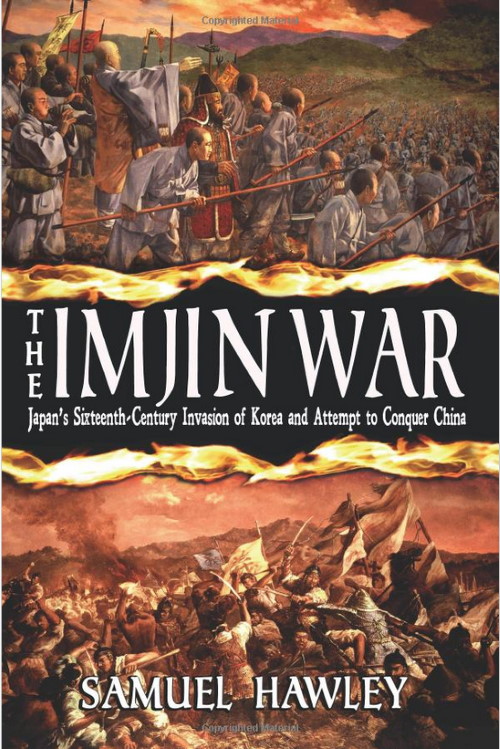
Samuel Hawley taught English in East Asia for many years. His books include Speed Duel, about the land speed rivalry in the 1960s between Craig Breedlove and Art Arfons; I Just Ran: Percy Williams, World’s Fastest Human, about one of Canada’s greatest yet least known sports heroes; the companion volumes America’s Man in Korea and Inside the Hermit Kingdom on George Foulk, America’s representative in Korea in the mid 1880s; and the novels Homeowner With a Gun and Bad Elephant Far Stream. He lives in Kingston, Ontario.
This
is a great book on a war that few in the West know about. [Equally
great, in my view, is Stephen Turnbull’s “Samurai Invasion: Japan’s
Korean War 1592 -1598.” Compared to Turnball, Hawley delves a little
deeper into the Korean perspective, while Turnball has a wealth of
detail on the Japanese. But this is not a criticism of either; I read
them both, Turnball first, then Hawley, and in so doing it reinforced
many of the key points of the war.]
One of the most gripping
chapters in Hawley’s book deals with “The Annals of The Chos’n Kingdom”
and how these priceless historical records were nearly destroyed.
Koreans are meticulous about record keeping, and the Annals which began
in 1413 CE and ended in 1910 are claimed to be the longest continual
record of a single dynasty in the world. They were written without
interference from the king and his court, and followed the Confucian
belief that records kept in the present would help future generations
learn from the past. It was also felt that record keeping encouraged
the living to follow principles of integrity and benevolence in order to
keep their own legacy unmarred, and that this sense of responsibility
towards one’s legacy should apply especially to the king.
As an
example of the independence of the Annals, there is an actual entry that
documents the king falling off his horse. Embarrassed that the fall
would enter into the Annals, he told his scribes not to record the fall.
They silently nodded and wrote away. The Annals recorded both the
fall, as well as the king’s order not to record the incident.
The
Koreans kept four identical copies of the Annals in different
locations, so that a fire or other disaster in one location would not
wipe out the entire historical record. During the Imjin War, the
invading Japanese army found and burned three copies of the Annals, and
narrowly missed the fourth. The last remaining copy was then taken to a
remote location where it survived the war. After the war, the court
used the surviving Annals to once more make additional copies of their
kingdom’s history.
Lessons from this book are as true today, as
they were in 1592: some wars begin because of a colossal
misunderstanding (the Japanese thought that the Koreans would welcome
them, and could not understand why they fought back); not keeping up
with the technology of the time can put you on the losing side (the
Koreans did not exploit the matchlock firearm, which was used by the
Japanese against them, to devastating effect); leadership is the
ultimate force-multiplier (Admiral Yi Sun-shin’s leadership of the
Korean Navy enabled it to rule the waves against the Japanese, even when
greatly outnumbered); politics and personal agendas frequently trump
the common good (one of Admiral Yi Sun-shin’s Korean rivals succeeded in
getting him fired during the war; he was later reinstated).
A
final observation is on the sheer savagery of war. In some battles, the
victorious Japanese killed every man, woman, child, dog, cat, cow, pig,
and chicken that they could. Both sides routinely cut the heads off
dead bodies, in order to bolster claims of battlefield success. At
least 60,000 Koreans lost their lives in the Second Battle of Chinju,
most of them massacred after the taking of the city. The Japanese sent
approximately 30,000 noses from dead Koreans to Japan as war trophies,
and to this day they remain buried in an enormous mound in Kyoto,
misnamed “The Mound of Ears.”
The war left Korea in terrible
shape, nearly bankrupt, and it took them centuries to recover and to
rebuild. As examples, two hundred years after the war ended, the
Koreans still could not afford to rebuild their destroyed palace in
Seoul, and agricultural production was still below pre-war levels.
Perhaps
even more than the 1910-1945 Japanese colonization of Korea, this war
goes a long way toward understanding why Koreans have ill feelings
toward Japan.
Hawley is to be commended for his scholarship, and for being a pretty good writer, too. The book is very readable.